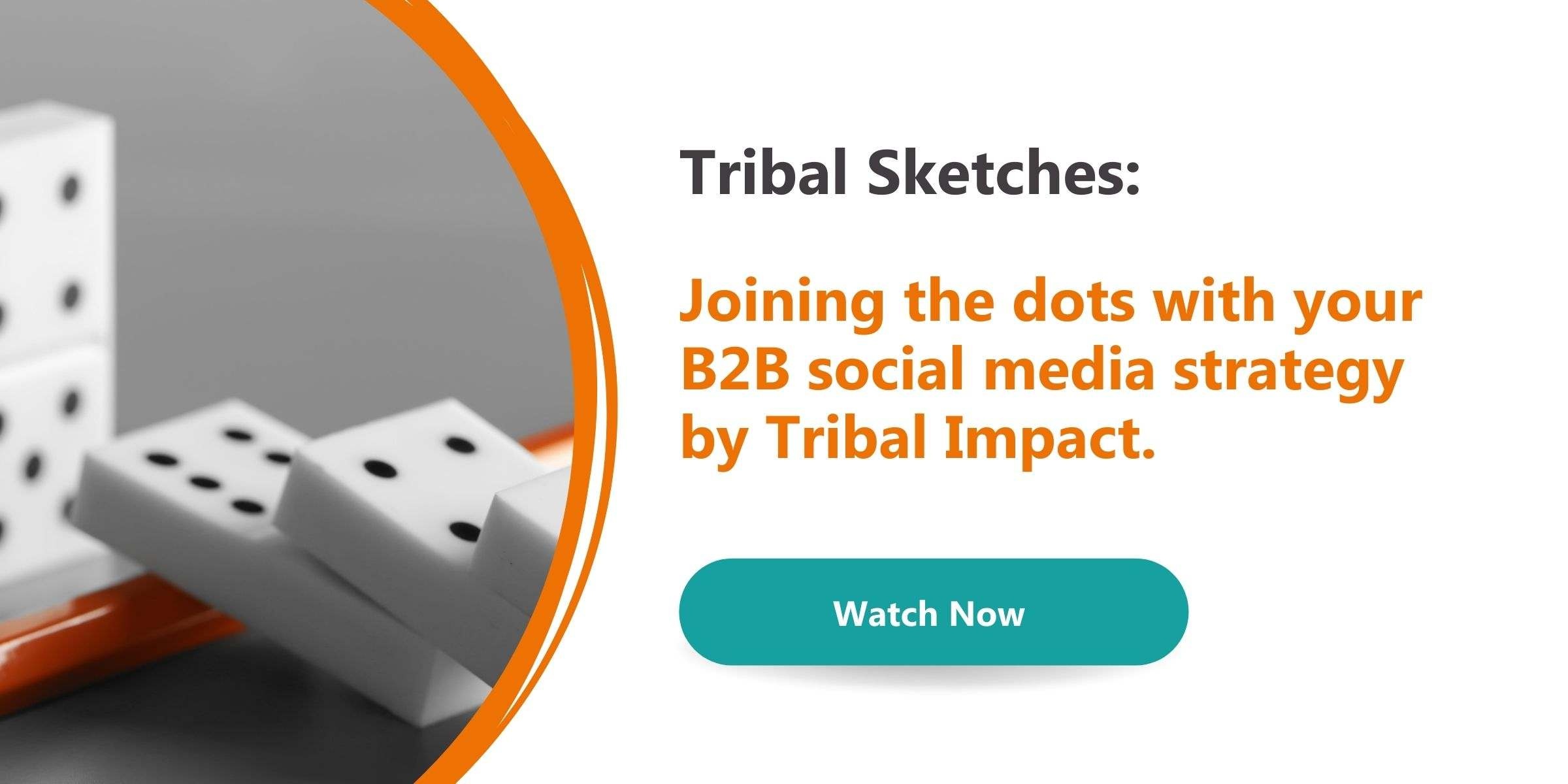
The right social media tool stack can make a big difference to the success of a B2B social media strategy. It can be a minefield knowing which ones are the best fit for your business, though.
Our CEO Sarah has put together a short, two-minute video explaining why this is so important. We recommend watching Sarah’s video first.
She goes into detail about each of the areas and how they can make a difference to your business, too. That video will give you more context for the rest of this post, explaining why each type of tool is important, so it’s worth checking it out before you keep reading.
Social Selling
Social selling is using social media to passively sell products or services. It’s a much more subtle way to sell than direct selling. It builds employees up as experts in their field, which organically increases brand trust and leads to more sales.
LinkedIn Sales Navigator is one of the most well-known social selling tools out there. It works well when paired with CrystalKnows, which can act as an add-on that helps you find out someone’s personality, adding further information which can inform personalised outreach efforts.
ZoomInfo is another option to Sales Navigator, although you could use the in conjunction if you wanted to. It’s one of the more complete options on the market.
Video is really useful for social selling efforts, which is why we love Vidyard. They have a free tier for quick videos, or a paid tier which allows you to download videos, make more edits, etc.
Here are the tools we recommend for social selling:
- LinkedIn Sales Navigator
- CrystalKnows
- Vidyard
- ZoomInfo
- Bombora
- 6sense
- Demandbase
Most of them do similar, or related things.
Or, like with Vidyard, they complement your social selling efforts to add more depth to relationships with customers by sending them really easy to record videos.
Employee Advocacy
Employee advocacy tools help reduce the barriers to getting employees to post on social media. They can be used to suggest content ideas for employees to share, which can encourage more employees to join in as they don’t have to spend time sourcing content to share.
Different platforms have different features, but on a basic level, they do the same thing.
Hootsuite Amplify is one of our favourites. It’s best for companies with over 1000 employees because of its advanced features and integrated analytics. It allows marketers to suggest content for employees to share to their social media profiles. Employees can then choose which content they share, and to where, then publish it to the profile of their choice. Content could include links, photos, or text-based posts.
Before making a decision, it’s worth considering what your budget is, and what features and integrations you need. This will affect which tool is the best choice for your business.
Employee advocacy tools to try:
- Hootsuite Amplify
- Sprinklr
- Dynamic Signal
- Smarp
- Bambu by Sprout
- Sociabble
- Oktopost
- PostBeyond
- EveryoneSocial
- DSMN8
- Ambassify
Influencer Marketing
Influencer marketing tools help with every stage of the influencer marketing process. They help you find influencers who can boost your brand, track the success of influencer content, and more.
BuzzSumo, which has a range of pricing plans, helps businesses to find the content that’s performing well in their industry – whether that’s theirs or someone else’s. Its analytics look at everything from search rankings to social media shares. This can help them find influencers to reach out to, and research the influencer’s brand and audience before connecting with them.
Aspire is focused on ecommerce businesses and has a creator marketplace for businesses to connect directly with influencers from within the platform, making it really easy to find related influencers.
Each one offers slightly different features, so consider what you’re looking to achieve, and who you want to connect with, before taking the plunge.
Some influencer marketing tools available include:
- Onalytica
- BuzzSumo
- AspireIQ
- Upfluence
- CreatorIQ
- Traackr
Monitoring & Listening
Monitoring and listening tools help you understand what people are saying about your business.
They can also help you find out what your target audience is talking about, so that you can tap into that conversation to show you’re an authority in your industry and build your brand and employees up as thought leaders.
If you need a free tool to start with, Google Alerts is the one for you. It allows you to track different keywords related to your business. When someone mentions that keyword, it’ll send you an email. It isn’t hugely in depth, but it is useful for helping you to track press coverage you might not have otherwise noticed.
Google Alerts is best for company-related updates. For instance, if someone publishes a blog about Tribal, we get an alert.
If you need something more in depth, we love Talkwalker. Talkwalker allows you to refine what you want to receive alerts for, and it allows you to get pretty specific. It’s the perfect tool for matching experts to the news about their topic.
For example, one of our clients used Talkwalker to find a problem that was arising for one of their target buyers. They used the building PR scandal to get the right type of content in front of their target buyer at the right time, which helped them to win them over as a client.
Monitoring and listening tools you could try include:
- Talkwalker
- Sprinklr
- Brandwatch
- Meltwater
- GoogleAlerts
- Falcon
- Mention
- Netbase
Governance & Security
The right governance and security tools can offer businesses piece of mind. They can also make managing social media accounts much easier.
Most password managers allow businesses to share logins with employees without passwords being visible, which means they can access the accounts they need to with minimal security risk.
It also means that if someone leaves the company, logins aren’t lost, they stay within the password manager.
Two-factor authentication is another big part of security. This prevents others from being able to login to an account without access to the mobile phone number or app associated with the account.
On sites that are at a high risk of being hacked, such as social media, two-factor authentication offers an additional layer of security for everyone involved, and can make it easier to get back into the account if something does happen.
Some security tools, such as LastPass, also allow you to store credit card data, which means employees don’t need to type bank details in each time they need to purchase something.
You can also get warnings if a password has been compromised or re-used passwords on multiple accounts.
Some of the governance and security tools we recommend include:
- ZeroFox
- CybelAngel
- LastPass
- BullGuard
- SocialHub
- LogDog
Publishing & Engagement
Publishing and engagement tools can streamline your social media scheduling. They can also help you notice the conversations your audience are having so that you can chime in with the right content at the right time.
Which publishing and engagement tool is right for you will depend on your budget, the features you want, and the integrations you need. Some of the tools we love don’t just specialise in social media scheduling, they also help with things like ABM.
If Twitter is your main platform and you’re on a budget, a tool like Tweetdeck is a great place to start. You can use it on your browser, or as an app on mobile or desktop. As it’s just for Twitter, it’s easy to follow lists, manage multiple accounts, and monitor hashtags.
If you need something that works on multiple platforms, Hootsuite, ContentCal, Buffer, or Lately may be more suitable for your needs. Some also provide a calendar view, which makes it easier to spot gaps in your content schedule.
HubSpot is an advanced all-in-one tool which includes social media scheduling. It’s expensive, but it can do just about everything.
Many of these tools also have built-in analytics, although how in depth those analytics are varies between platforms and tools.
Some of the publishing and engagement tools we recommend include:
- Hootsuite
- ContentCal
- Lately
- Buffer
- Sprinklr
- Sprout Social
- Socialbakers
- HubSpot
- Tweetdeck
- Zoho
Analysis Tools
Analysis tools help you track if your content is supporting your business goals. Without them, you have no idea if what you’re doing is actually working or not.
There are many tools on the market which can track things like the performance of your social media and website.
Google Analytics is a free tool to track your website performance. It’s one of the most in-depth website analytics tools out there, but because of this, it can have a steep learning curve. Google offers a free course to help you get to grips with it, which you can find at Digital Garage.
BuzzSumo also helps to track website performance, but in a different way – it can show you the total number of social shares a page or post has received online. This is really useful for identifying what topics are popular with your audience.
Twitter Analytics is a must if Twitter is one of your main platforms. It shows you which tweets are performing well, who your most engaged followers are, and which post type performs the best for you. It also shows which of your followers has the biggest audience, which is another way to identify influencers.
You can track tweet performance by type of tweet and over length of time, which can help you to spot trends in the types of tweets that perform well for you.
If you’re not sure on Twitter’s built-in analytics, FollowerWonk and Audiense also specialise in Twitter and have different packages depending on your needs.
Other analysis tools include:
- Google Analytics
- Twitter Analytics
- BuzzSumo
- Onalytica
- FollowerWonk (Twitter)
- Hashtagify.me
- Pulsar
- Rival IQ
- Socialbakers
- Audiense (Twitter)
Content Tools
The right content tools makes content creation easier. It also ensures what you publish is more effective at helping you achieve your goals. In this section, we’ll take a look at some of the different content tools out there.
Canva is an easy to use graphic design tool. It has templates for just about everything, as well as stock images which you can use in your graphics.
Paid plans also allow you to upload your brand logo, fonts, and colours, so that they’re always there when you – or your team – need them. It also has animation and video options.
An alterantive to Canva is WordSwag. It's a mobile app where you can quickly add text to videos.
If video is more your focus, check out Vidyard. Its paid plans allow you to edit videos and give you more control over the finished product. If you just want to record a quick video, you can use it for free.
Alternatively, if you want to do a screen recording demo, UseLoom is perfect. It’s up to you if that screenshare includes your video in it, audio recording, or just the screenshare itself.
Content tools we love:
- Canva
- Lately
- Biteable
- WordSwag
- Vidyard
- UseLoom
Conclusion
Knowing which tools you need in your social media tool stack can be a real challenge. Choosing the wrong one can mean it’s less effective at helping you achieve your business goals, so it’s worth taking the time to plan and research before committing to any of the tools on the list.
